In this article:
Typhoid fever is a bacterial infection that can result in multiple symptoms, including fever, headache, and abdominal pain. However, one of the less commonly known consequences of typhoid fever is hair loss. (1)(2)
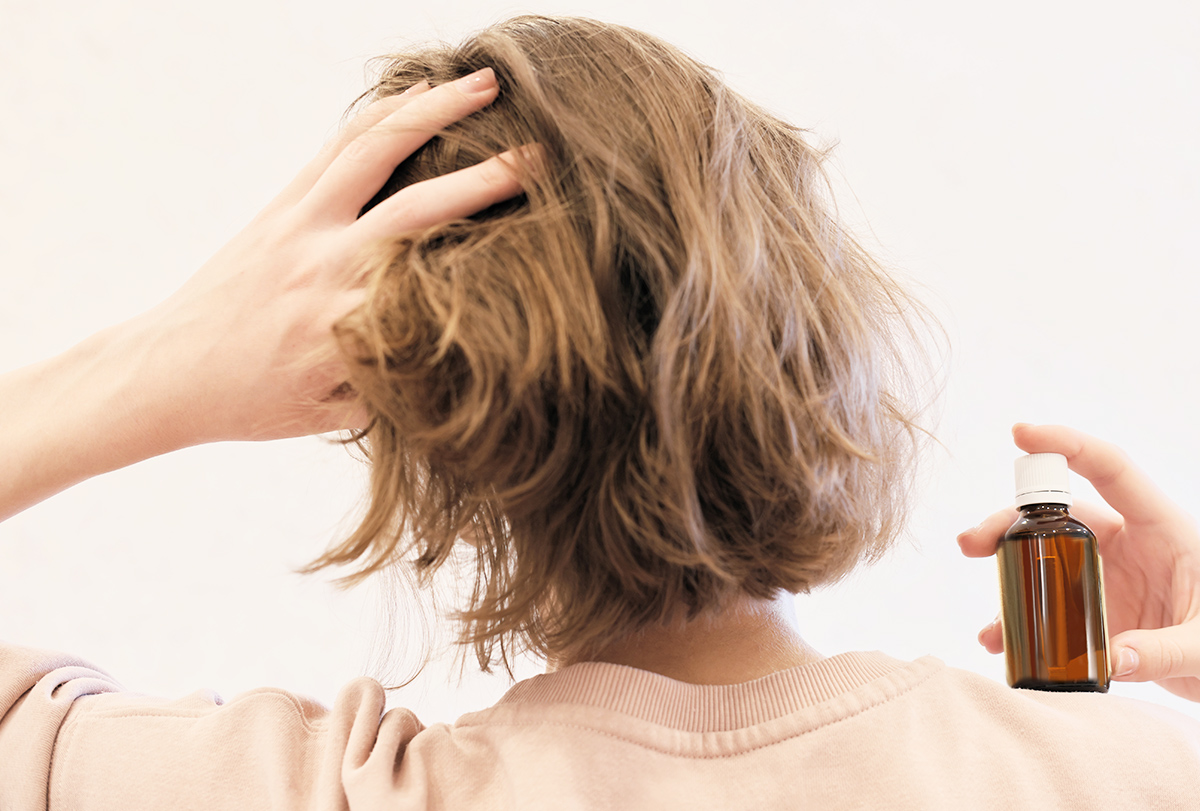
Hair loss after typhoid is not uncommon, and it can be troubling for those affected by it. This hair fall is known as telogen effluvium.
Thankfully, many home fixes can prevent and reverse hair loss after typhoid.
Home Remedies for Hair Loss After Typhoid
Here are some home remedies you can try to fight hair loss due to typhoid.
1. Perform a scalp massage

Massaging the scalp can stimulate blood circulation and facilitate hair growth. Routine scalp massage can also alleviate stress, which can be a contributing aspect to hair loss after typhoid. (3)(4)
To perform a scalp massage to promote hair growth:
- Place yourself in a comfortable spot where you can effortlessly reach your scalp.
- Using your fingers, massage your scalp in circular motions for 3–5 minutes. Apply mild force and do not use your nails.
- Ensure to cover your whole scalp.
2. Apply onion juice to your hair
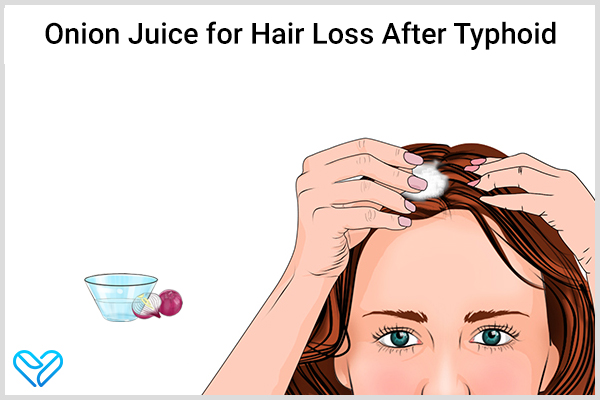
Onion juice is a potent home remedy for hair loss. It contains high levels of sulfur, which can enhance blood circulation to the scalp and stimulate hair growth. (5)
To use onion juice to facilitate hair growth:
- Peel and chop 1–2 onions and add them to a blender to take out the juice.
- Apply the onion juice straight to your scalp.
- Massage your scalp well.
- Leave the onion juice on your scalp for 15–30 minutes, based on your comfort level.
- Wash your hair with shampoo to remove the onion juice.
3. Apply coconut oil to your hair
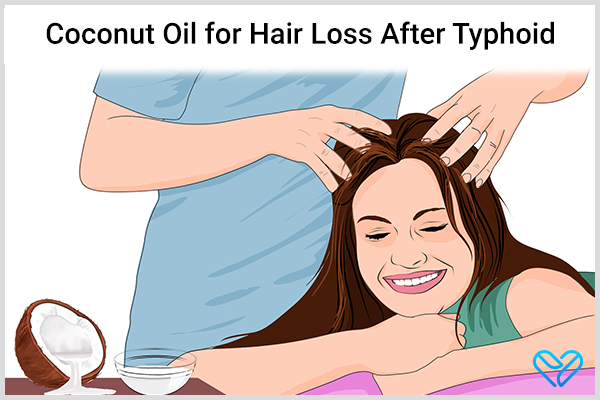
Coconut oil is a useful home treatment for hair loss. Its chemical composition includes fatty acids such as myristic acid, capric acid, lauric acid, and monolaurin, making it one of the wealthiest sources of fatty acids.
Coconut oil also displays antifungal action. It can create a layer over the hair shaft, plugging the cuticle and trapping moisture inside, thereby behaving as an emollient. It also aids in detangling hair and flattening the cuticle, which can improve the health and impression of the hair strands.
Additionally, its low molecular weight and unique build enable it to penetrate the hair shaft, discouraging the loss of protein from the hair. (6)
4. Use fresh aloe vera on your hair
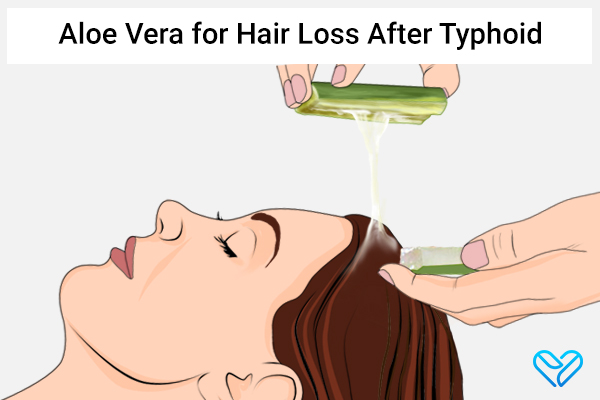
Aloe vera contains enzymes that can stimulate hair growth, as well as amino acids and vitamins that can nurture and reinforce the hair follicles.
Aloe vera has been researched for its usefulness in hair care, mainly in the treatment of seborrheic dermatitis (SD), which induces rash and scales on the scalp. One study disclosed that aloe vera enormously reduced itchiness, scaliness, and the extent of the affected area in SD.
As SD can result in transient hair loss in some cases, aloe vera is assumed to be helpful in stimulating hair growth. (7)
To use aloe vera on your hair:
- Dissect a fresh aloe vera leaf and remove the gel.
- Apply the gel to your scalp and hair, massaging them gently.
- Leave it on for about 30 minutes.
- Rinse your hair with lukewarm water and shampoo as usual.
- Repeat this procedure 1–2 times a week for visible results.
5. Apply a fenugreek seed paste to your hair
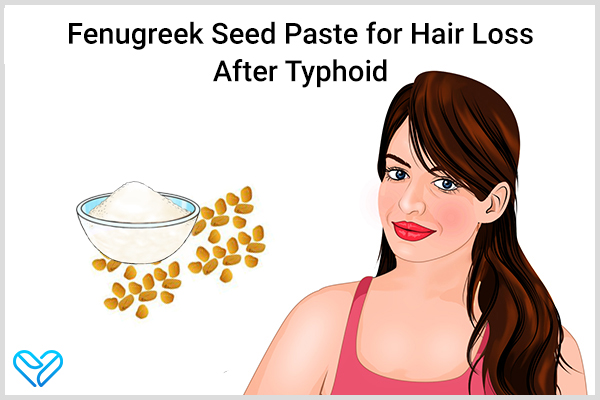
Fenugreek is an herb that has been employed for years for medicinal and culinary purposes. In current times, fenugreek oil has earned fame for its probable advantages in hair care.
One of the hair benefits of fenugreek oil is its power to fight androgenetic alopecia, a type of hair loss that affects both men and women.
Fenugreek seeds comprise diosgenin, which has been demonstrated to have estrogenic activity that may hinder the production of dihydrotestosterone, a hormone that is related to androgenetic alopecia.
Fenugreek also contains flavonoids and trigonelline, which can stimulate vasodilation in the scalp, boosting blood flow to the hair follicles. (6)
To use fenugreek seeds to improve hair growth:
- Soak fenugreek seeds in water overnight.
- Crush them into a paste.
- Apply the paste to your scalp and hair, and leave it on for 30 minutes.
- Wash it off.
6. Use egg yolk on your hair
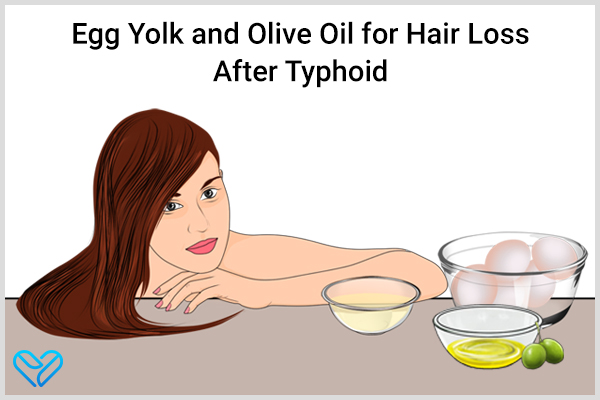
Recent research indicates that egg yolk may be a possible treatment for hair loss.
A study established that water-soluble peptides derived from egg yolk enable the production of vascular endothelial growth factor (VEGF), which is crucial for hair growth. These peptides were also studied to improve hair growth in female-pattern hair loss.
These results show that egg yolk may be a promising option over hair growth drugs such as minoxidil, which can have adverse effects with long-term use. (8)
To use egg yolk to improve hair growth:
- Mix the yolk of 1 egg with 1 tbsp of olive oil.
- Apply the mixture to your scalp and hair, leaving it on for 30 minutes.
- Wash it off with water.
7. Follow a balanced diet

A balanced and healthy diet is critical for discouraging and reversing hair loss after typhoid. Consuming nutrient-rich foods can supply the body with the nutrients it requires to nurture healthy hair growth.
Moreover, consuming foods high in iron, zinc, fatty acids, protein, and biotin can help restore nutrient deficiencies caused by illness and fight hair loss due to these deficiencies. (9)
Foods that are great for hair development include:
- Spinach
- Eggs
- Salmon
- Sweet potatoes
- Avocados
- Almonds
- Berries
Medical Interventions to Manage Hair Loss After Typhoid
If home remedies do not work, medical therapies can be prescribed. Doctors may suggest medications and other interventions to manage hair loss after typhoid.

1. Minoxidil
Minoxidil is a topical solution used on the scalp to facilitate hair growth. It functions by broadening blood vessels in the scalp, which improves blood flow and nutrient delivery to the hair follicles.
Minoxidil is available over the counter and can be utilized by both men and women. (10)
2. Finasteride
Finasteride is an oral drug that is FDA-approved in the therapy of male-pattern baldness. It functions by obstructing the transformation of testosterone to dihydrotestosterone (DHT), which is the hormone accountable for hair loss in men.
Finasteride is not suggested for use in children and should not be used by pregnant women or women who may become pregnant. (11)
3. Homeopathic approach
Homeopathy, a natural medicine approach, can be good for resolving hair loss (12) after typhoid.
A homeopathic solution made from Thuja orientalis has been famously employed to manage hair loss. Researchers found that applying Thuja orientalis to the skin stimulates hair growth via the rejuvenation of old hair follicles.
Consult a qualified homeopathic practitioner to assist you with post-typhoid hair care. (13)
4. Ayurvedic approach
Ayurveda can aid in managing hair loss after typhoid by employing treatments that cleanse the body of toxins. By combining solutions such as purgation and herbal medicines, Ayurveda facilitates hair regrowth.
This holistic intervention finds the root cause of the hair problem and delivers suitable treatment naturally. (14)(15)
Most-Asked Questions
Can home remedies alone treat hair loss after typhoid?
If the hair loss is minimal, home remedies may be useful.
How long does it take for home remedies to show results?
Home remedies can take many weeks or even months to show results.
What things should be avoided when managing hair loss after typhoid?
Using harsh chemicals or hot styling tools can further damage the already weakened hair and hence should be avoided.
Can stress management techniques help with hair loss after typhoid?
Yes, stress can contribute to hair loss after typhoid, and methods such as meditation, yoga, and therapy may help manage stress and facilitate hair growth.
Final Word
Hair loss after typhoid can be distressing. Fortunately, several home remedies and medical treatments can help.
Maintaining a healthy diet, managing stress, and using natural remedies such as aloe vera and onion juice can all help promote hair growth.
- Was this article helpful?
- YES, THANKS!NOT REALLY


